Attached files
| file | filename |
|---|---|
| 8-K - FORM 8-K - FEDERAL NATIONAL MORTGAGE ASSOCIATION FANNIE MAE | d307690d8k.htm |
| EX-99.1 - EXHIBIT 99.1 - FEDERAL NATIONAL MORTGAGE ASSOCIATION FANNIE MAE | d307690dex991.htm |
 February 29, 2012
Fannie Mae
2011 Credit Supplement
Exhibit 99.2 |
 1
This presentation includes information about Fannie Mae, including
information contained in Fannie Mae’s Annual Report on Form 10-K for
the year ended December 31, 2011, the “2011 Form 10-K.”
Some of the
terms used in these materials are defined and discussed more fully in
the 2011 Form 10-K. These materials should be reviewed together with
the 2011 Form 10-K, copies of which are available on the “SEC
Filings” page in the “Investors”
section of Fannie Mae’s Web site at
www.fanniemae.com.
Some of the information in this presentation is based upon information
that we received from third-party sources such as sellers and servicers
of mortgage loans. Although we generally consider this information
reliable, we do not independently verify all reported information.
This presentation includes forward-looking statements relating to future
home price changes. These statements are based on our opinions,
analyses, estimates, forecasts and other views on a variety of economic
and other information, and changes in the assumptions and other
information underlying these views could produce materially different
results.
The impact of future home price changes on our business,
results or financial condition will depend on many other factors.
Due to rounding, amounts reported in this presentation may not add to
totals indicated (or 100%). A zero indicates less than one half of one
percent. A dash indicates a null value. |
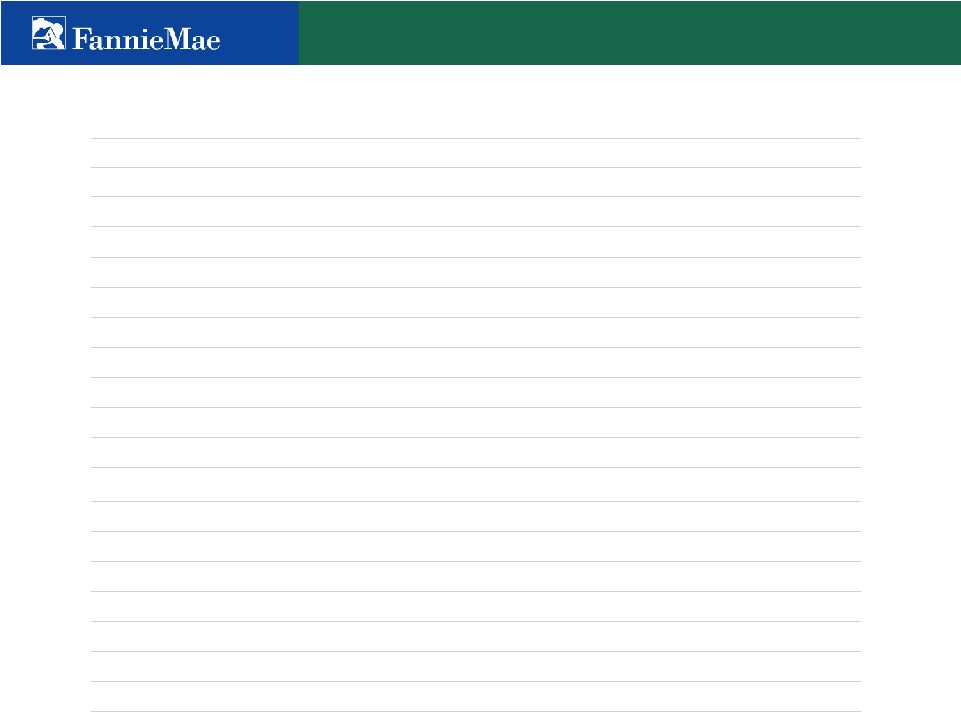 2
Table of Contents
Slide
Home Price Growth/Decline Rates in the U.S.
3
Home Price Change Peak-to-Current as of 2011 Q4
4
Fannie Mae Acquisition Profile by Key Product Features
5
Fannie Mae Credit Profile by Key Product Features
6
Fannie Mae Credit Profile by Origination Year and Key Product Features
7
Fannie Mae Credit Profile by State
8
Fannie Mae Alt-A Credit Profile by Key Product Features
9
Fannie Mae Single-Family Serious Delinquency Rates by State and Region
10
Fannie Mae Single-Family Completed Workouts by Type
11
Home Affordable Modification Program (HAMP)
12
Fannie Mae Single-Family Loan Modifications by Monthly Payment Change and
Type 13
Performance of Fannie Mae Modified Loans
14
Fannie Mae Single-Family Cumulative Default Rates
15
Fannie Mae Single-Family Real Estate Owned (REO) in Selected States
16
Fannie Mae Multifamily Credit Profile by Loan Attributes
17
Fannie Mae Multifamily Credit Profile by Acquisition Year
18
Fannie Mae Multifamily Credit Profile
19
Fannie Mae Multifamily 2011 Credit Losses by State
20 |
 3
7.0%
6.3%
7.5%
7.7%
10.6%
11.3%
2.8%
-3.3%
-9.0%
-4.7%
-4.3%
-3.2%
-10%
-5%
0%
5%
10%
15%
2000
2001
2002
2003
2004
2005
2006
2007
2008
2009
2010
2011
Home Price Growth/Decline Rates in the U.S.
S&P/Case-Shiller
Index 9.8% 7.7% 10.6% 10.7%
14.6% 14.7% -0.3%
-8.4% -18.4% -2.5% -3.7% -4.0%
Fannie Mae Home Price Index
Growth rates are from period-end to period-end.
We expect peak-to-trough declines in home prices to be in the 23% to 30%
range (comparable to a decline in the 32% to 40% range using the
S&P/Case-Shiller index method).
*Estimate based on purchase transactions in Fannie-Freddie acquisition and
public deed data available through the end of January 2012. Including subsequent data may lead to materially
different results.
*
Note: Our estimates differ from the S&P/Case-Shiller index in two principal ways: (1) our
estimates weight expectations by number of properties, whereas the S&P/Case-Shiller index
weights expectations based on property value, causing home price declines on higher priced homes to
have a greater effect on the overall result; and (2) the S&P/Case-Shiller index
includes sales of foreclosed homes while our estimates attempt to exclude foreclosed homes sales,
because we believe that differing maintenance practices and the forced nature of the sales make
foreclosed home prices less representative of market values. We believe, however, that the impact of sales of foreclosed homes is reflected in our estimates as a result
of their impact on the pricing of non-distressed sales. We recently enhanced our home price
estimates to identify and exclude a greater portion of foreclosed home sales. As a result, some
period to period comparisons of home prices differ from those indicated by our prior estimates. We estimate the S&P/Case-Shiller comparison numbers by adjusting our internal
home price estimates to compensate for weighting based on property value and the impact of foreclosed
property sales. In addition to these differences, our estimates are based on our own internally
available data combined with publicly available data, and are therefore based on data collected nationwide, whereas the S&P/Case-Shiller index is based on publicly
available data, which may be limited in certain geographic areas of the country. Our comparative
calculations to the S&P/Case-Shiller index provided above are not modified to account
for this data pool difference. |
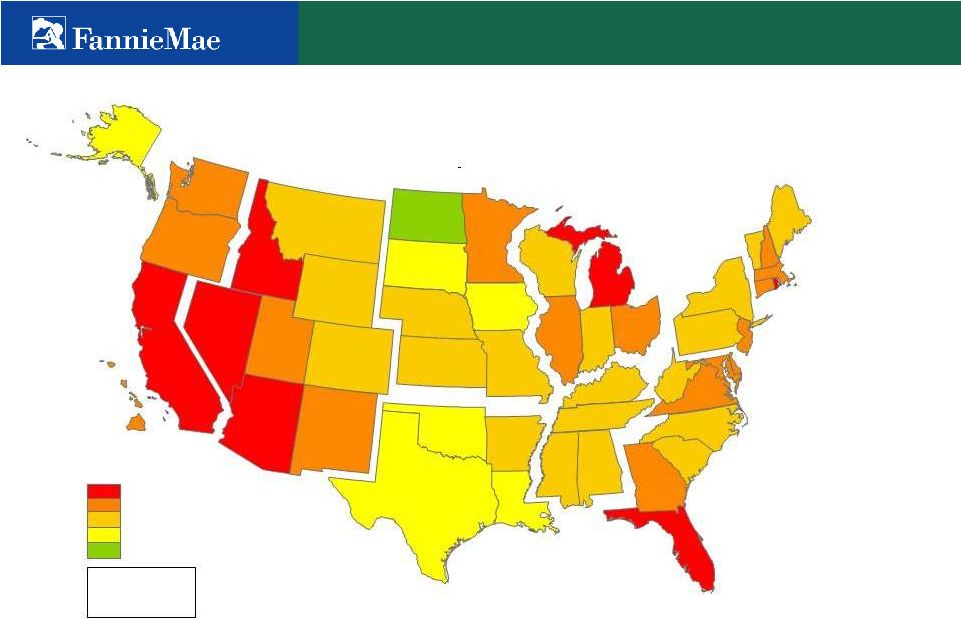 4
Top %: State/Region Home Price Decline Rate percentage from applicable peak
in that state/region through December 31, 2011. Bottom %: Percent of
Fannie Mae single-family conventional guaranty book of business by unpaid principal balance as of December 31, 2011.
Note: Regional home price decline percentages are a housing stock unit-weighted
average of home price decline percentages of states within each region.
*Source:
Fannie
Mae.
Estimates
based
on
purchase
transactions
in
Fannie-Freddie
acquisition
and
public
deed
data
available
through
the
end
of
January
2012.
Including
subsequent
data
may
lead to materially different results.
RI
-33.3%
0.4%
DC
-12.0%
0.4%
TX
-4.2%
5.1%
MT
-10.9%
0.3%
WY
-9.7%
0.2%
CO
-12.4%
2.4%
ND
0.0%
0.1%
KS
-6.1%
0.5%
NE
-5.3%
0.4%
SD
-1.6%
0.2%
OK
-3.0%
0.6%
MO
-12.8%
1.4%
IA
-3.5%
0.6%
AR
-6.9%
0.5%
MS
-9.2%
0.4%
WI
-14.1%
1.8%
PA
-9.6%
3.0%
AL
-11.2%
1.0%
IN
-8.2%
1.2%
LA
-2.5%
0.9%
KY
-5.1%
0.6%
NC
-12.5%
2.5%
NY
-12.0%
5.6%
TN
-11.1%
1.4%
ME
-11.4%
0.3%
SC
-14.4%
1.3%
WV
-5.4%
0.2%
MD
-29.8%
2.9%
VT
-10.5%
0.2%
NH
-21.8%
0.5%
MA
-20.0%
3.1%
NJ
-26.5%
4.0%
CT
-20.7%
1.4%
DE
-20.0%
0.4%
CA
-46.9%
18.7%
NM
-16.2%
0.6%
AZ
-52.4%
2.4%
NV
-61.3%
1.0%
OR
-29.5%
1.6%
UT
-23.8%
1.0%
MN
-23.4%
1.8%
ID
-31.6%
0.5%
WA
-27.7%
3.5%
GA
-28.7%
2.8%
IL
-26.7%
4.3%
OH
-15.1%
2.3%
FL
-51.1%
6.4%
MI
-32.0%
2.5%
VA
-21.4%
3.6%
Home
Price
Change
Peak
-
to-Current as of 2011 Q4
United States -23.0%
United States -23.0%
West North Central
11.7%
5.0%
Mountain
-34.3%
8.4%
West South Central
-3.8%
7.0%
East South Central
-9.5%
3.4%
East North Central
-20.7%
12.1%
New England
-19.1%
5.9%
Middle Atlantic
-13.8%
12.6%
South Atlantic
-31.0%
20.3%
Pacific
-41.1%
24.8%
State
Growth Rate
UPB%
State Growth
Below -30%
-30% to -15%
-5% to 0%
-15% to -5%
0%
State Growth
Below -30%
-30% to -15%
-5% to 0%
-15% to -5%
0%
AK
-1.6%
0.2%
HI
-24.4%
0.8% |
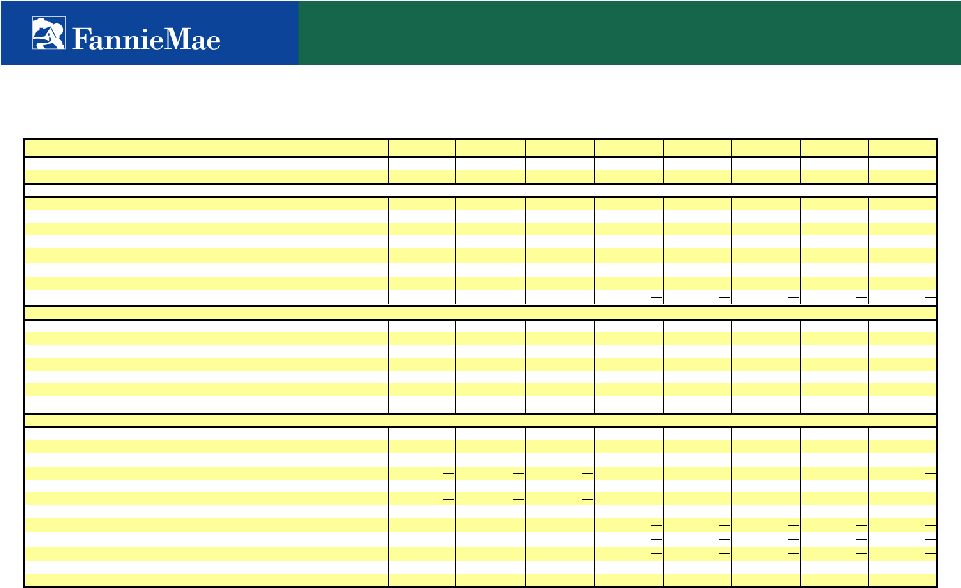 5
Fannie Mae Acquisition Profile by Key Product Features
(1)
Percentage
calculated
based
on
unpaid
principal
balance
of
loans
at
time
of
acquisition.
Single-family
business
volume
refers
to
both
single-family
mortgage
loans
we
purchased
for
our
mortgage
portfolio
and
single-family
mortgage
loans
we
guaranty
into
Fannie
Mae
MBS.
Beginning
with
the
third
quarter
of
2011,we
prospectively
report
loans
underlying
long-
term standby commitments in the period in which the commitment was established,
rather than at the time of actual delivery. (2)
The
increase
for
2010
and
2011
is
the
result
of
our
Refi
Plus™
initiative,
which
involves
the
refinance
of
existing
Fannie
Mae
loans
with
loan-to-value
ratios
up
to
125%.
(3)
Refi Plus and Home Affordable Refinance Program (HARP) started in April 2009.
(4)
FICO credit scores as reported by the seller of the mortgage loan at the time of
delivery. (5)
Newly originated Alt-A loans acquired in 2009, 2010, and 2011 consist of the
refinance of existing Alt-A loans under our Refi Plus initiative.
Acquisition Year
2011
2010
2009
2008
2007
2006
2005
2004
Unpaid Principal Balance (billions)
562.3
$
595.0
$
684.7
$
557.2
$
643.8
$
515.8
$
524.2
$
568.8
$
Weighted Average Origination Note Rate
4.35%
4.64%
4.93%
6.00%
6.51%
6.45%
5.73%
5.63%
Origination Loan-to-Value Ratio
<= 60%
29.1%
30.3%
32.6%
22.7%
16.7%
18.6%
21.4%
23.1%
>60% and <= 70%
15.5%
15.9%
17.0%
16.1%
13.5%
15.1%
16.3%
16.2%
>70% and <= 80%
37.3%
38.5%
39.9%
39.5%
44.7%
49.6%
46.2%
43.1%
>80% and <= 90%
8.9%
8.6%
6.9%
11.7%
9.1%
6.8%
7.4%
8.2%
>90% and <= 100%
(2)
6.8%
5.2%
3.3%
10.0%
15.8%
9.7%
8.5%
9.3%
> 100%
(2)
2.3%
1.6%
0.4%
0.1%
0.1%
0.2%
0.2%
0.2%
Weighted Average Origination Loan-to-Value Ratio
69.3%
68.4%
66.8%
72.0%
75.5%
73.4%
72.0%
71.4%
Weighted Average Origination Loan-to-Value Ratio Excluding HARP
(3)
67.0%
66.0%
65.8%
FICO Credit Scores
(4)
0 to < 620
0.5%
0.4%
0.4%
2.8%
6.4%
6.2%
5.4%
5.6%
>= 620 and < 660
1.8%
1.6%
1.5%
5.7%
11.5%
11.2%
10.7%
11.5%
>=660 and < 700
7.0%
6.6%
6.5%
13.9%
19.2%
19.6%
18.9%
19.4%
>=700 and < 740
16.2%
16.1%
17.2%
21.7%
22.6%
23.0%
23.2%
23.9%
>=740
74.5%
75.1%
74.4%
55.8%
40.1%
39.7%
41.5%
39.2%
Missing
0.1%
0.1%
0.1%
0.1%
0.1%
0.2%
0.3%
0.4%
Weighted Average FICO Credit Score
(4)
762
762
761
738
716
716
719
715
Product Distribution
Fixed-rate
93.5%
93.7%
96.6%
91.7%
90.1%
83.4%
78.7%
78.8%
Adjustable-rate
6.5%
6.3%
3.4%
8.3%
9.9%
16.6%
21.3%
21.2%
Alt-A
(5)
1.2%
0.9%
0.2%
3.1%
16.7%
21.8%
16.1%
11.9%
Subprime
0.3%
0.7%
0.7%
0.0%
Interest Only
0.7%
1.3%
1.0%
5.6%
15.2%
15.2%
10.1%
5.0%
Negative Amortizing
0.0%
0.3%
3.1%
3.2%
1.9%
Refinance
76.5%
77.4%
79.9%
58.6%
50.4%
48.3%
53.1%
57.3%
Total Refi Plus
(3)
24.3%
23.4%
10.6%
HARP
(3)
8.5%
9.0%
3.8%
HARP Weighted Average Origination Loan-to-Value Ratio
(3)
94.1%
92.1%
90.7%
Investor
6.5%
4.6%
2.5%
5.6%
6.5%
7.0%
6.4%
5.4%
Condo/Co-op
8.8%
8.6%
8.2%
10.3%
10.4%
10.5%
9.8%
8.8%
Credit Characteristics
of Single-Family
Business
Volume
(1)
|
 6
Fannie Mae Credit Profile by Key Product Features
Credit Characteristics of Single-Family Conventional Guaranty Book of
Business As of December 31, 2011
Negative
Amortizing
Loans
Interest Only
Loans
Loans with FICO
< 620
(3)
Loans with FICO
620 and < 660
(3)
Loans with
Origination LTV
Ratio
> 90%
Loans with FICO <
620 and
Origination LTV
Ratio > 90%
(3)
Alt-A Loans
Subprime Loans
Sub-total of
Key Product
Features
(1)
Overall
Book
Unpaid Principal Balance (billions)
(2)
$9.1
$130.2
$87.5
$184.9
$275.6
$19.0
$182.2
$5.8
$713.6
$2,761.5
Share of Single-Family Conventional Guaranty Book
0.3%
4.7%
3.2%
6.7%
10.0%
0.7%
6.6%
0.2%
25.8%
100.0%
Average Unpaid Principal Balance
(2)
$111,563
$241,567
$120,420
$133,263
$154,490
$118,106
$158,541
$146,954
$150,663
$156,194
Serious Delinquency Rate
7.57%
15.27%
13.47%
10.16%
8.08%
18.67%
12.43%
23.18%
9.59%
3.91%
Origination Years 2005-2008
55.4%
82.4%
60.2%
56.1%
44.9%
65.3%
71.0%
85.2%
56.3%
30.4%
Weighted Average Origination Loan-to-Value Ratio
70.6%
74.8%
76.7%
77.0%
97.5%
98.2%
73.4%
77.0%
81.4%
71.4%
Origination Loan-to-Value Ratio > 90%
0.3%
8.9%
21.7%
20.2%
100.0%
100.0%
6.7%
6.7%
38.6%
10.0%
Weighted Average Mark-to-Market Loan-to-Value Ratio
100.8%
117.9%
91.1%
91.8%
110.5%
114.8%
101.4%
111.2%
99.7%
79.3%
Mark-to-Market Loan-to-Value Ratio > 100% and <= 125%
12.9%
24.8%
18.2%
17.4%
36.0%
34.2%
19.2%
23.7%
24.0%
10.4%
Mark-to-Market Loan-to-Value Ratio > 125%
34.9%
36.5%
14.8%
15.6%
19.6%
27.0%
23.9%
28.2%
18.7%
7.5%
Weighted Average FICO
(3)
707
725
587
641
713
591
717
620
692
738
FICO < 620
(3)
6.8%
1.4%
100.0%
6.9%
100.0%
0.9%
49.8%
12.3%
3.2%
Fixed-rate
1.0%
31.0%
80.3%
82.9%
88.5%
77.6%
66.6%
65.2%
76.0%
89.3%
Primary Residence
68.7%
85.3%
96.6%
94.1%
95.5%
99.0%
77.6%
96.8%
89.9%
89.5%
Condo/Co-op
13.5%
16.1%
4.8%
6.5%
10.1%
5.8%
10.4%
4.3%
9.5%
9.4%
Credit Enhanced
(4)
55.1%
17.0%
29.1%
27.4%
72.2%
85.9%
16.3%
59.4%
35.3%
14.0%
% of 2007 Credit Losses
(5)
0.9%
15.0%
18.8%
21.9%
17.4%
6.4%
27.8%
1.0%
72.3%
100.0%
% of 2008 Credit Losses
(5)
2.9%
34.2%
11.8%
17.4%
21.3%
5.4%
45.6%
2.0%
81.3%
100.0%
% of 2009 Credit Losses
(5)
2.0%
32.6%
8.8%
15.5%
19.2%
3.4%
39.6%
1.5%
75.0%
100.0%
% of 2010 Credit Losses
(5)
1.9%
28.6%
8.0%
15.1%
15.9%
2.7%
33.2%
1.1%
68.4%
100.0%
% of 2011 Credit Losses
(5)
0.8%
22.3%
8.1%
15.2%
16.2%
2.4%
24.4%
0.9%
62.2%
100.0%
(1)
Loans with multiple product features are included in all applicable categories. The subtotal is
calculated by counting a loan only once even if it is included in multiple categories.
(2)
Excludes non-Fannie Mae securities held in portfolio and those Alt-A and subprime wraps for
which Fannie Mae does not have loan-level information. Fannie Mae had access to
detailed loan-level information for over 99% of its single-family conventional guaranty book
of business as of December 31, 2011.
(3)
FICO credit scores as reported by the seller of the mortgage loan at the time of delivery.
(4)
Unpaid principal balance of all loans with credit enhancement as a percentage of unpaid principal
balance of single-family conventional guaranty book of business for which Fannie Mae had
access to loan level information. Includes primary mortgage insurance, pool insurance, lender recourse and other credit enhancement.
(5)
Expressed as a percentage of credit losses for the single-family guaranty book of business. For
information on total credit losses, refer to Fannie Mae's 2011 Form 10-K.
|
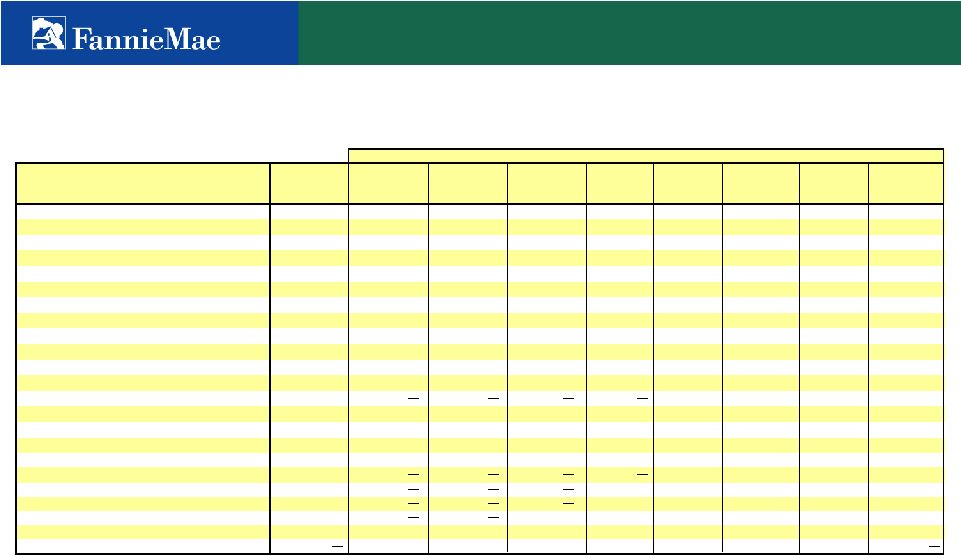 7
Fannie
Mae
Credit
Profile
by
Origination
Year
and
Key
Product
Features
As of December 31, 2011
Overall
Book
2011
2010
2009
2008
2007
2006
2005
2004 and
Earlier
Unpaid Principal Balance (billions)
(1)
$2,761.5
$447.6
$517.7
$460.7
$192.7
$269.0
$186.8
$190.5
$496.5
Share of Single-Family Conventional Guaranty Book
100.0%
16.2%
18.7%
16.7%
7.0%
9.7%
6.8%
6.9%
18.0%
Average
Unpaid
Principal
Balance
(1)
$156,194
$202,870
$203,020
$194,685
$174,124
$174,199
$158,845
$144,931
$91,672
Serious Delinquency Rate
3.91%
0.04%
0.24%
0.55%
5.64%
12.62%
11.81%
7.27%
3.31%
Weighted Average Origination Loan-to-Value Ratio
71.4%
69.8%
69.3%
68.2%
75.1%
78.5%
75.4%
73.1%
70.5%
Origination Loan-to-Value Ratio > 90%
(2)
10.0%
10.0%
7.7%
4.9%
13.1%
21.3%
12.6%
9.3%
9.0%
Weighted Average Mark-to-Market Loan-to-Value Ratio
79.3%
70.4%
71.3%
72.7%
92.2%
112.0%
111.1%
95.1%
60.9%
Mark-to-Market Loan-to-Value Ratio > 100% and <= 125%
10.4%
3.3%
4.5%
5.9%
23.9%
26.8%
22.7%
17.8%
5.7%
Mark-to-Market Loan-to-Value Ratio > 125%
7.5%
0.2%
0.3%
0.4%
10.9%
29.0%
29.4%
18.2%
2.8%
Weighted
Average
FICO
(3)
738
761
762
759
729
704
707
715
717
FICO
<
620
(3)
3.2%
0.5%
0.4%
0.5%
3.5%
8.5%
7.0%
5.2%
5.7%
Interest Only
4.7%
0.6%
1.0%
0.9%
6.2%
15.9%
17.4%
10.6%
2.1%
Negative Amortizing
0.3%
0.1%
1.2%
1.4%
0.8%
Fixed-rate
89.3%
93.6%
94.8%
97.3%
86.6%
78.4%
76.7%
78.6%
87.9%
Primary Residence
89.5%
88.5%
90.6%
92.0%
87.2%
88.3%
86.4%
86.9%
90.5%
Condo/Co-op
9.4%
8.8%
8.6%
8.7%
12.1%
11.3%
11.6%
10.7%
7.8%
Credit Enhanced
(4)
14.0%
9.8%
7.2%
7.2%
28.0%
32.1%
21.4%
16.5%
12.1%
%
of
2007
Credit
Losses
(5)
100.0%
1.9%
21.3%
23.6%
53.2%
%
of
2008
Credit
Losses
(5)
100.0%
0.5%
27.9%
34.9%
19.3%
17.3%
%
of
2009
Credit
Losses
(5)
100.0%
4.8%
36.0%
30.9%
16.4%
11.9%
%
of
2010
Credit
Losses
(5)
100.0%
0.4%
7.0%
35.8%
29.2%
15.9%
11.7%
%
of
2011
Credit
Losses
(5)
100.0%
0.1%
1.1%
1.9%
7.1%
29.1%
27.4%
18.1%
15.1%
Cumulative
Default
Rate
(6)
0.0%
0.06%
0.17%
2.52%
9.03%
8.60%
5.13%
Origination Year
(1)
Excludes non-Fannie Mae securities held in portfolio and those Alt-A and subprime wraps for
which Fannie Mae does not have loan-level information. Fannie Mae had access to detailed
loan-level information for over 99% of its single-family conventional guaranty book of
business as of December 31, 2011.
(2)
The increase for 2010 and 2011 is the result of our Refi Plus loans, which started in April 2009, and
involve the refinance of existing Fannie Mae loans with loan-to-value ratios up to 125%.
(3)
FICO credit scores as reported by the seller of the mortgage loan at the time of delivery. (4)
Unpaid principal balance of all loans with credit enhancement as a percentage of unpaid principal
balance of single-family conventional guaranty book of business for which Fannie Mae has
access to loan-level information. Includes primary mortgage insurance, pool insurance,
lender recourse and other credit enhancement.
(5)
Expressed as a percentage of credit losses for the single-family guaranty book of business. For
information on total credit losses, refer to Fannie Mae's 2011 Form 10-K.
(6)
Defaults include loan liquidations other than through voluntary pay-off or repurchase by lenders
and include loan foreclosures, preforeclosure sales, sales to third parties and deeds in lieu of
foreclosure. Cumulative Default Rate is the total number of single-family conventional loans in
the guaranty book of business originated in the identified year that have defaulted, divided by
the total number of single-family conventional loans in the guaranty book of business originated
in the identified year. For 2000 to 2004 cumulative default rates, refer to slide 15.
Credit Characteristics of Single-Family Conventional Guaranty Book of Business by Origination
Year |
 8
Fannie Mae Credit Profile by State
Credit Characteristics of Single-Family Conventional Guaranty Book of Business
by State As of December 31, 2011
Overall
Book
AZ
CA
FL
NV
Select
Midwest
States
(5)
Unpaid
Principal
Balance
(billions)
(1)
$2,761.5
$66.9
$516.6
$175.3
$28.8
$284.1
Share of Single-Family Conventional Guaranty Book
100.0%
2.4%
18.7%
6.3%
1.0%
10.3%
Average
Unpaid
Principal
Balance
(1)
$156,194
$149,921
$222,280
$139,647
$161,348
$122,247
Serious Delinquency Rate
3.91%
3.65%
2.46%
11.80%
7.42%
4.39%
Origination Years 2005-2008
30.4%
45.1%
25.3%
53.0%
50.9%
28.7%
Weighted Average Origination Loan-to-Value Ratio
71.4%
74.7%
65.0%
73.7%
75.1%
75.2%
Origination Loan-to-Value Ratio > 90%
10.0%
12.2%
4.7%
11.4%
10.4%
13.8%
Weighted Average Mark-to-Market Loan-to-Value Ratio
79.3%
108.6%
80.8%
107.9%
137.6%
83.7%
Mark-to-Market Loan-to-Value Ratio >100% and <=125%
10.4%
18.3%
10.4%
16.9%
15.3%
15.7%
Mark-to-Market Loan-to-Value Ratio >125%
7.5%
29.9%
11.7%
32.1%
51.7%
7.3%
Weighted
Average
FICO
(2)
738
739
748
724
733
733
FICO < 620
(2)
3.2%
2.6%
1.7%
4.8%
2.6%
4.1%
Interest Only
4.7%
9.5%
7.0%
8.8%
13.4%
2.9%
Negative Amortizing
0.3%
0.4%
1.0%
0.8%
1.0%
0.1%
Fixed-rate
89.3%
83.8%
86.2%
83.5%
77.2%
89.1%
Primary Residence
89.5%
81.5%
87.7%
82.2%
78.8%
93.3%
Condo/Co-op
9.4%
4.6%
11.9%
14.1%
6.1%
10.9%
Credit Enhanced
(3)
14.0%
13.5%
6.1%
15.7%
14.3%
17.9%
%
of
2007
Credit
Losses
(4)
100.0%
1.8%
7.2%
4.7%
1.2%
46.6%
%
of
2008
Credit
Losses
(4)
100.0%
8.0%
25.2%
10.9%
4.9%
21.1%
%
of
2009
Credit
Losses
(4)
100.0%
10.8%
24.4%
15.5%
6.5%
14.8%
%
of
2010
Credit
Losses
(4)
100.0%
10.0%
22.6%
17.5%
6.1%
13.6%
%
of
2011
Credit
Losses
(4)
100.0%
7.1%
20.2%
16.4%
4.6%
17.3%
(1)
Excludes non-Fannie Mae securities held in portfolio and those Alt-A and subprime wraps for
which Fannie Mae does not have loan-level information. Fannie Mae had access to
detailed loan-level information for over 99% of its single-family conventional guaranty book of business as of December 31, 2011.
(2)
FICO credit scores as reported by the seller of the mortgage loan at the time of delivery. (3)
Unpaid principal balance of all loans with credit enhancement as a percentage of unpaid principal
balance of single-family conventional guaranty book of business for which Fannie Mae has
access to loan-level information. Includes primary mortgage insurance, pool insurance, lender recourse and other credit enhancement.
(4)
Expressed as a percentage of credit losses for the single-family guaranty book of business.
For information on total credit losses, refer to Fannie Mae's 2011 Form 10-K. (5)
Select Midwest states are Illinois, Indiana, Michigan and Ohio. |
 9
Fannie Mae Alt-A Credit Profile by Key Product Features
Credit Characteristics of Alt-A Single-Family Conventional Guaranty Book of
Business by Origination Year As of December 31, 2011
Alt-A
(1)
2011
(2)
2010
(2)
2009
(2)
2008
2007
2006
2005
2004 and
Earlier
Unpaid
principal
balance
(billions)
(3)
$182.2
$6.1
$4.1
$1.5
$4.4
$44.5
$47.3
$33.1
$41.2
Share of Alt-A
100.0%
3.4%
2.3%
0.8%
2.4%
24.4%
26.0%
18.2%
22.6%
Weighted Average Origination Loan-to-Value Ratio
73.4%
73.7%
78.9%
74.8%
68.2%
75.1%
74.3%
72.8%
71.0%
Origination
Loan-to-Value
Ratio
>
90%
(4)
6.7%
23.9%
28.2%
20.3%
2.6%
8.5%
4.9%
3.3%
4.9%
Weighted Average Mark-to-Market Loan-to-Value Ratio
101.4%
75.0%
83.2%
81.7%
88.4%
117.0%
118.4%
105.3%
69.4%
Mark-to-Market Loan-to-Value Ratio > 100% and <=125%
19.2%
13.0%
19.9%
18.9%
19.7%
25.0%
23.2%
19.7%
8.8%
Mark-to-Market Loan-to-Value Ratio > 125%
23.9%
1.2%
0.7%
1.5%
10.8%
34.2%
35.3%
26.3%
5.7%
Weighted
Average
FICO
(5)
717
744
734
735
724
710
711
722
718
FICO < 620
(5)
0.9%
2.6%
3.2%
3.6%
0.3%
0.6%
0.6%
0.4%
1.5%
Adjustable-rate
33.4%
2.2%
4.4%
3.7%
21.6%
33.9%
38.5%
43.8%
28.6%
Interest Only
27.4%
0.1%
7.2%
37.0%
37.4%
29.6%
13.7%
Negative Amortizing
2.6%
3.8%
6.0%
2.3%
Investor
17.8%
22.5%
12.0%
5.4%
18.6%
19.1%
16.7%
20.0%
16.0%
Condo/Co-op
10.4%
6.8%
9.5%
8.8%
6.8%
9.3%
11.2%
12.9%
9.7%
California
21.1%
25.3%
19.9%
16.0%
20.4%
21.1%
18.6%
20.1%
24.4%
Florida
11.9%
4.0%
3.5%
3.4%
9.8%
13.1%
14.1%
13.6%
9.1%
Credit
Enhanced
(6)
16.3%
2.1%
2.3%
1.5%
14.2%
18.0%
16.0%
15.6%
19.6%
2010 Serious Delinquent Rate
13.87%
0.44%
2.24%
10.29%
20.39%
19.41%
13.22%
6.44%
2011 Serious Delinquent Rate
12.43%
0.21%
2.11%
4.25%
10.70%
18.46%
17.55%
12.19%
6.65%
%
of
2007
Credit
Losses
(7)
27.8%
0.7%
9.8%
9.7%
7.7%
%
of
2008
Credit
Losses
(7)
45.6%
0.0%
12.4%
20.1%
9.7%
3.4%
% of 2009 Credit Losses
(7)
39.6%
0.4%
13.4%
15.8%
7.3%
2.6%
%
of
2010
Credit
Losses
(7)
33.2%
0.0%
0.0%
0.5%
11.8%
12.8%
5.7%
2.3%
%
of
2011
Credit
Losses
(7)
24.4%
0.1%
0.1%
0.3%
7.0%
9.2%
5.4%
2.4%
Cumulative
Default
Rate
(8)
0.0%
0.58%
1.64%
7.21%
16.89%
16.08%
10.27%
(1)
“Alt-A mortgage loan” generally refers to a mortgage loan that can be underwritten with
reduced or alternative documentation than that required for a full documentation mortgage loan but may also include
other alternative product features. In reporting our Alt-A exposure, we have classified mortgage
loans as Alt-A if the lenders that deliver the mortgage loans to us have classified the loans as Alt-A based on
documentation or other product features. We have loans with some features that are similar to
Alt-A mortgage loans that we have not classified as Alt-A because they do not meet our classification
criteria.We have classified private-label mortgage-related securities held in our investment
portfolio as Alt-A if the securities were labeled as such when issued.
(2)
Newly originated Alt-A loans acquired in 2009, 2010, and 2011 consist of the refinance of
Alt-A existing loans under our Refi Plus initiative.
(3)
Excludes non-Fannie Mae securities held in portfolio and those Alt-A and subprime wraps for
which Fannie Mae does not have loan-level information. Fannie Mae had access to detailed loan-level
information for over 99% of its single-family conventional guaranty book of business as of
December 31, 2011.
(4)
The increase for 2009, 2010, and 2011 is the result of Refi Plus loans, which started in April 2009
and can have loan-to-value ratios up to 125%.
(5)
FICO credit scores as reported by the seller of the mortgage loan at the time of delivery.
(6)
Defined as unpaid principal balance of Alt-A loans with credit enhancement as a percentage of
unpaid principal balance of all Alt-A loans. At December 31, 2011, 10.1% of unpaid principal balance of Alt-A
loans carried only primary mortgage insurance (no deductible), 4.8% had only pool insurance (which is
generally subject to a deductible), 1.1% had primary mortgage insurance and pool insurance, and 0.4%
carried other credit enhancement such as lender recourse.
(7)
Expressed as a percentage of credit losses for the single-family guaranty book of business. For
information on total credit losses, refer to Fannie Mae's 2011 Form 10-K.
(8)
Defaults include loan liquidations other than through voluntary pay-off or repurchase by lenders
and includes loan foreclosures, preforeclosure sales, sales to third parties and deeds in lieu of foreclosure.
Cumulative Default Rate is the total number of single-family conventional loans in the guaranty
book of business originated in the identified year that have defaulted, divided by the total number of single-
family conventional loans in the guaranty book of business originated in the identified year. |
 10
Fannie Mae Single-Family Serious Delinquency Rates by State and Region
(1)
(1)
Calculated based on the number of loans in Fannie Mae’s single-family
conventional guaranty book of business within each specified category.
(2)
Select Midwest states are Illinois, Indiana, Michigan, and Ohio.
(3)
For information on which states are included in each region, refer to footnote 9
to Table 41 in Fannie Mae’s 2011 Form 10-K. Select Midwest Sates
(2)
Serious Delinquency Rate by States
0%
2%
4%
6%
8%
10%
12%
14%
16%
2011 Q4
2011 Q3
2011 Q2
2011 Q1
2010 Q4
2010 Q3
2010 Q2
2010 Q1
2009 Q4
2009 Q3
2009 Q2
2009 Q1
2008 Q4
AZ
CA
FL
NV
All
Serious Delinquency Rate by Region
(3)
0%
1%
2%
3%
4%
5%
6%
7%
8%
2011 Q4
2011 Q3
2011 Q2
2011 Q1
2010 Q4
2010 Q3
2010 Q2
2010 Q1
2009 Q4
2009 Q3
2009 Q2
2009 Q1
2008 Q4
Midwest
Northeast
Southeast
Southwest
West |
 11
Fannie Mae Single-Family Completed Workouts by Type
105,297
78,079
80,195
87,533
82,684
0
30,000
60,000
90,000
120,000
2010 Q4
2011 Q1
2011 Q2
2011 Q3
2011 Q4
Modifications
Repayment Plans Completed
Forbearances Completed
Preforeclosure Sales and Deeds-in-Lieu
Modifications involve changes to the original mortgage loan terms, which may include a change to the
product type, interest rate, amortization term, maturity date and/or unpaid principal
balance. Modifications include completed modifications made under the Administration's Home Affordable
Modification Program (HAMP), which was implemented in March 2009, but do not reflect loans currently
in trial modifications. Information on Fannie Mae loans under the Home Affordable
Modification Program is provided on Slide 12. Repayment plans involve plans to repay past due principal and interest over a reasonable period of
time through temporarily higher monthly payments. Loans with completed repayment plans are
included for loans that were at least 60 days delinquent at initiation.
Forbearances involve an agreement to suspend or reduce borrower payments for a period of time. Loans
with forbearance plans are included for loans that were at least 90 days delinquent at
initiation.
Deeds in lieu of foreclosure involve the borrower’s voluntarily signing over title to the
property.
In a preforeclosure sale, the borrower, working with the servicer, sells the home prior to foreclosure
to pay off all or part of the outstanding loan, accrued interest and other expenses from the
sale proceeds. |
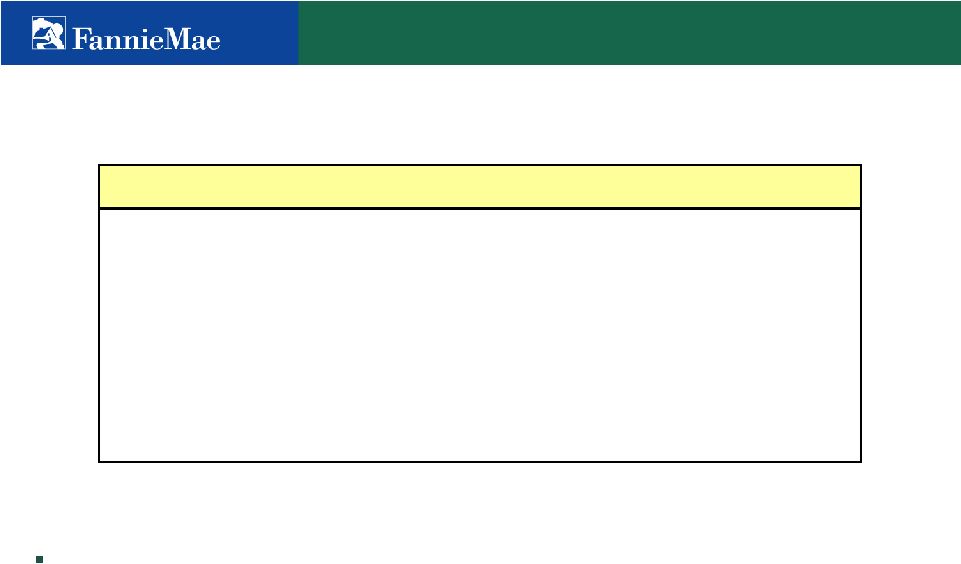 12
Provides immediate payment relief to borrowers who are delinquent or in imminent
risk of payment default. Home Affordable Modification Program (HAMP)
Data Source: United States Treasury Department as reported by servicers to the
system of record for the Home Affordable Modification Program, except for
the percentage of seriously delinquent loans. Fannie Mae Loans Under
HAMP As of December 31, 2011 reporting period
Active HAMP Trials
Active Permanent HAMP
Modifications
(1)
Total
21,698
245,415
Modification Structure
Rate Reduction
93%
100%
Term Extension
67%
67%
Forbearance
21%
27%
Median Monthly Interest and
Principal Payment Reduction
% of December 31, 2011 Seriously
Delinquent Loans
$428
$488
2%
(1)
Active Permanent HAMP modifications exclude modifications on loans that
subsequently canceled because the loans were 90+ days delinquent or paid off. |
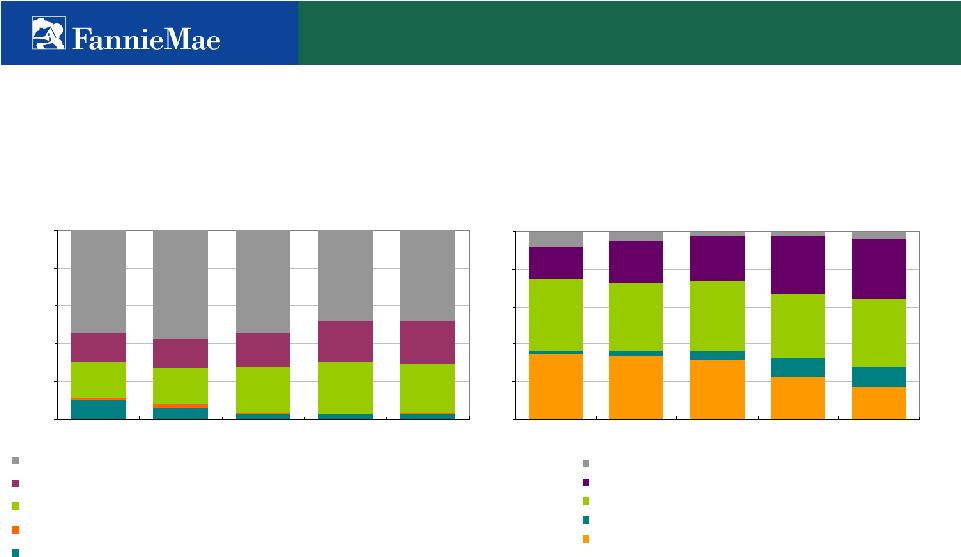 13
Fannie Mae Single-Family Loan Modifications by Monthly Payment
Change and Type
Change in Monthly Principal and Interest Payment
of Modified Single-Family Loans
(1)(2)
(1)
Excludes loans that were classified as subprime adjustable rate mortgages that were
modified into fixed rate mortgages and were current at the time of modification. Modifications
include permanent modifications, but do not reflect loans currently in trial
modifications. (2)
Represents the change in the monthly principal and interest payment at the
effective date of the modification. The monthly principal and interest payment on modified loans may
vary, and may increase, during the remaining life of the loan.
Modification Type of Single-Family Loans
(1)(2)
0%
20%
40%
60%
80%
100%
Q4 2010
Q1 2011
Q2 2011
Q3 2011
Q4 2011
Capitalization of Missed Payments and Other
Extend Term, Reduce Rate and Forbear Principal
Extend Term and Reduce Rate
Extend Term Only
Reduce Rate Only
0%
20%
40%
60%
80%
100%
Q4 2010
Q1 2011
Q2 2011
Q3 2011
Q4 2011
Decrease of greater than 30% of Principal and Interest Payment
Decrease of greater than 20% but less than or equal to 30% of Principal and Interest Payment
Decrease of less than or equal to 20% of Principal and Interest Payment
No Change in Principal and Interest Payment
Increase in Principal and Interest Payment |
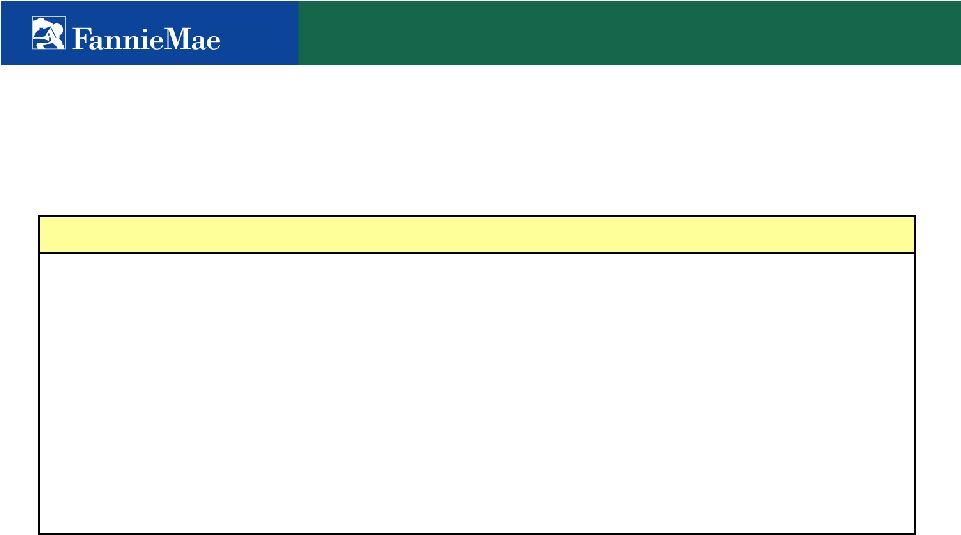 14
Performance of Fannie Mae Modified Loans
Re-performance Rates of Modified Single-Family Loans
(1)
(1)
Excludes loans that were classified as subprime adjustable rate mortgages that were
modified into fixed rate mortgages and were current at the time of modification. Modifications
include permanent modifications, but do not reflect loans currently in trial
modifications. (2)
Includes loans that are paid off.
2009
2009
2010
2010
2010
2010
2011
2011
2011
Q3
Q4
Q1
Q2
Q3
Q4
Q1
Q2
Q3
3 months post modification
57%
78%
80%
79%
78%
81%
84%
84%
83%
6 months post modification
47%
69%
71%
73%
75%
77%
78%
79%
n/a
9 months post modification
45%
62%
65%
71%
73%
72%
75%
n/a
n/a
12 months post modification
42%
58%
65%
70%
70%
69%
n/a
n/a
n/a
15 months post modification
40%
60%
63%
66%
67%
n/a
n/a
n/a
n/a
18 months post modification
41%
58%
60%
65%
n/a
n/a
n/a
n/a
n/a
21 months post modification
40%
56%
59%
n/a
n/a
n/a
n/a
n/a
n/a
24 months post modification
39%
55%
n/a
n/a
n/a
n/a
n/a
n/a
n/a
% Current and Performing
(2) |
 15
Note: Defaults include loan liquidations other than through voluntary pay-off
or repurchase by lenders and include loan foreclosures, preforeclosure sales, sales to third parties and deeds in
lieu
of
foreclosure.
Cumulative
Default
Rate
is
the
total
number
of
single-family
conventional
loans
in
the
guaranty
book
of
business
originated
in
the
identified
year
that
have
defaulted,
divided by the total number of single-family conventional loans in the guaranty
book of business originated in the identified year. Data as of December 31,
2011 are not necessarily indicative of the ultimate performance of the loans and performance is likely to change, perhaps materially, in future
periods.
Fannie Mae Single-Family Cumulative Default Rates
Cumulative Default Rates of Single-Family Conventional Guaranty Book of Business
by Origination Year 2000
2001
2002
2003
2004
2005
2006
2007
2008
2009
2010
2011
0.0%
0.5%
1.0%
1.5%
2.0%
2.5%
3.0%
3.5%
4.0%
4.5%
5.0%
5.5%
6.0%
6.5%
7.0%
7.5%
8.0%
8.5%
9.0%
9.5%
10.0%
Yr1-Q1
Yr2-Q1
Yr3-Q1
Yr4-Q1
Yr5-Q1
Yr6-Q1
Yr7-Q1
Yr8-Q1
Yr9-Q1
Yr10-Q1
Yr11-Q1
Yr12-Q1
Time Since Beginning of Origination Year
2000
2001
2002
2003
2004
2005
2006
2007
2008
2009
2010
2011 |
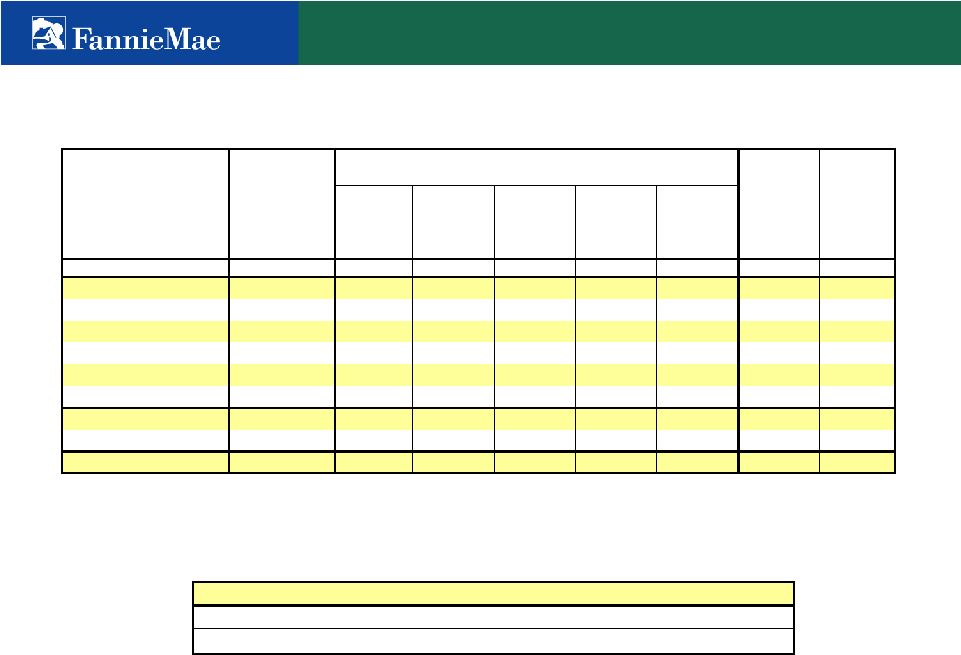 16
Fannie Mae Single-Family Real Estate Owned (REO) in Selected
States
(1)
Select Midwest States are Illinois, Indiana, Michigan and Ohio.
(2)
Measured from the last monthly period for which the borrowers fully paid their
mortgages to when the related properties were added to our REO inventory for foreclosures
completed during 2011.
(3)
Fannie Mae incurs additional costs associated with property taxes, hazard
insurance, and legal fees while a delinquent loan remains in the foreclosure process. Additionally, the
longer a loan remains in the foreclosure process, the longer it remains in our
guaranty book of business as a seriously delinquent loan. The average number of days from
delinquency to foreclosure for all states combined were 327, 325, 407, 479, and 529
in the years 2007 through 2011, respectively. 2011
2010
2009
2008
2007
2006
2005
55%
57%
55%
68%
78%
83%
87%
REO Net Sales Prices Compared With Unpaid Principal Balances of Mortgage Loans
2011
2010
2009
2008
2007
Beginning Balance
NA
162,489
86,155
63,538
33,729
25,125
NA
NA
Arizona
401
16,172
20,691
12,854
5,532
751
4,385
9,400
California
529
27,589
34,051
19,565
10,624
1,681
14,147
20,164
Florida
890
13,748
29,628
13,282
6,159
1,714
8,677
18,621
Nevada
513
8,406
9,418
6,075
2,906
530
2,833
4,895
Select Midwest States
(1)
534
33,777
45,411
28,464
23,668
16,678
29,614
35,354
All other States
499
100,004
122,879
65,377
45,763
27,767
58,872
74,055
Total Acquisitions
NA
199,696
262,078
145,617
94,652
49,121
NA
NA
Total Dispositions
NA
(243,657)
(185,744)
(123,000)
(64,843)
(40,517)
NA
NA
Ending Inventory
NA
118,528
162,489
86,155
63,538
33,729
NA
NA
REO
Inventory as
of December
31, 2011
REO
Inventory
as of
December
31, 2010
REO Acquisitions and Dispositions (Number of Properties)
Average Days
From Last Paid
Installment to
Foreclosure
(2) (3)
State |
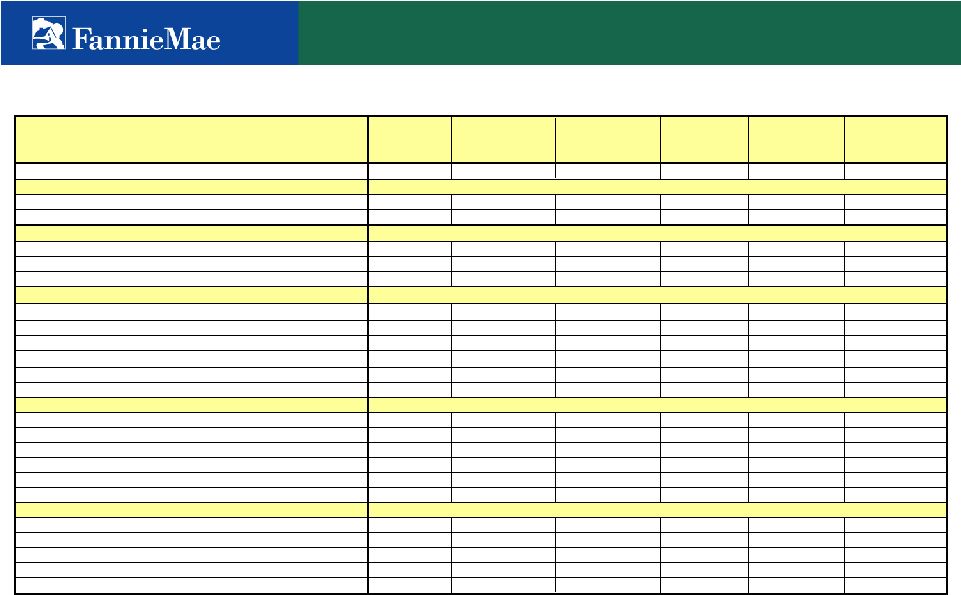 17
Fannie Mae Multifamily Credit Profile by Loan Attributes
Total
Multifamily
Guaranty
Book
of
Business
(1)
40,305
$192.7
100%
0.59%
100%
100%
Credit Enhanced Loans:
Credit Enhanced
36,131
$173.1
90%
0.55%
83%
68%
Non-Credit Enhanced
4,174
$19.6
10%
0.88%
17%
32%
Originating
loan-to-value
ratio:
(3)
Less than or equal to 70%
25,265
$102.0
53%
0.23%
18%
8%
Greater than 70% and less than or equal to 80%
11,879
$81.8
42%
0.82%
70%
89%
Greater than 80%
3,161
$9.0
5%
2.51%
12%
3%
Delegated
Underwriting
and
Servicing
(DUS
®)
Loans:
(4)
DUS ®
-
Small Balance Loans
(5)
7,827
$15.0
8%
0.45%
9%
7%
DUS
®
-
Non
Small
Balance
Loans
11,380
$140.0
72%
0.51%
72%
61%
DUS
®
-
Total
19,207
$154.9
80%
0.50%
81%
68%
Non-DUS -
Small Balance Loans
(5)
19,822
$16.7
9%
1.38%
12%
10%
Non-DUS -
Non Small Balance Loans
1,276
$21.1
11%
0.57%
7%
22%
Non-DUS -
Total
21,098
$37.8
20%
0.92%
19%
32%
Maturity Dates:
Loans maturing in 2012
1,388
$9.2
5%
0.59%
7%
15%
Loans maturing in 2013
3,182
$18.1
9%
0.43%
7%
10%
Loans maturing in 2014
2,624
$14.6
8%
0.82%
5%
11%
Loans maturing in 2015
3,205
$16.5
9%
0.57%
6%
4%
Loans maturing in 2016
3,139
$16.7
9%
0.78%
8%
14%
Other maturities
26,767
$117.6
61%
0.56%
68%
46%
Loan Size Distribution:
Less than or equal to $750K
11,875
$3.8
2%
1.24%
5%
2%
Greater than $750K and less than or equal to $3M
14,592
$21.5
11%
1.04%
16%
16%
Greater than $3M and less than or equal to $5M
4,713
$17.2
9%
0.66%
11%
17%
Greater than $5M and less than or equal to $25M
8,038
$81.1
42%
0.64%
50%
48%
Greater than $25M
1,087
$69.3
36%
0.33%
18%
17%
% of 2011
Multifamily
Credit
Losses
% of 2010
Multifamily
Credit
Losses
As of December 31, 2011
Unpaid
Principal
Balance
(Billions)
% of Multifamily
Guaranty Book of
Business (UPB)
% Seriously
Delinquent
(2)
Loan
Counts
(1)
Excludes loans that have been defeased. Defeasance is prepayment of a loan through substitution
of collateral.
(2)
We classify multifamily loans as seriously delinquent when payment is 60 days or more past due. (3)
Weighted Average Original loan-to-value ratio is 66% as of December 31, 2011. (4)
Under the Delegated Underwriting and Servicing, or DUS ®, product line, Fannie Mae purchases
individual, newly originated mortgages from specially approved DUS lenders using DUS
underwriting standards and/or DUS loan documents. Because DUS lenders generally share the risk of loss with Fannie Mae, they are able
to originate, underwrite, close and service most loans without our pre-review. (5)
Multifamily loans under $3 million and up to $5 million in high cost of living areas. |
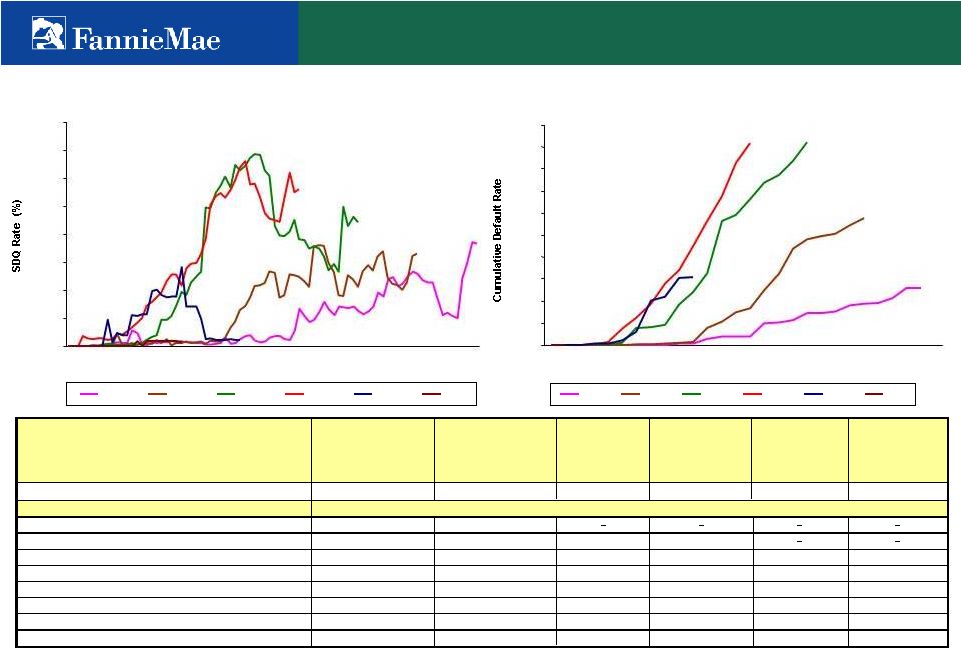 18
(1)
Excludes loans that have been defeased. Defeasance is prepayment of a loan
through substitution of collateral. (2)
We classify multifamily loans as seriously delinquent when payment is 60 days or
more past due. Fannie Mae Multifamily Credit Profile by Acquisition Year
Multifamily SDQ Rate by Acquisition Year
Cumulative Defaults by Acquisition Year
2005
2006
2007
2008
2009
2010
0.00%
0.20%
0.40%
0.60%
0.80%
1.00%
1.20%
1.40%
1.60%
Year
1
Year
2
Year
3
Year
4
Year
5
Year
6
Year
7
2005
2006
2007
2008
2009
2010
2009
0.00%
0.20%
0.40%
0.60%
0.80%
1.00%
1.20%
1.40%
1.60%
1.80%
2.00%
Year
1
Year
2
Year
3
Year
4
Year
5
Year
6
Year
7
2005
2006
2007
2008
2009
2010
2005
2007
2008
2006
As of December 31, 2011
Unpaid Principal
Balance (Billions)
% of Multifamily
Guaranty Book of
Business (UPB)
% Seriously
Delinquent
(2)
# of Seriously
Delinquent
loans
(2)
% of 2011
Multifamily
Credit Losses
% of 2010
Multifamily
Credit Losses
Total Multifamily Guaranty Book of Business
(1)
$192.7
100%
0.59%
385
100%
100%
By Acquisition Year:
2011
$24.2
13%
2010
$17.1
9%
0.04%
1
2009
$18.2
9%
0.05%
2
6%
2%
2008
$30.6
16%
1.12%
92
31%
17%
2007
$38.3
20%
0.89%
162
33%
38%
2006
$17.4
9%
0.66%
35
7%
17%
2005
$14.8
8%
0.73%
25
3%
2%
Prior to 2005
$32.2
17%
0.66%
68
20%
25% |
 19
Fannie Mae Multifamily Credit Profile
(1)
Excludes loans that have been defeased. Defeasance is prepayment of a loan through substitution
of collateral.
(2)
We classify multifamily loans as seriously delinquent when payment is 60 days or more past due. (3)
For information on which states are included in each region, refer to Fannie Mae’s 2011 Form
10-K.
(4)
Asset Class Definitions: Conventional/Co-Op Housing: Privately owned multifamily properties
or multifamily properties in which the residents collectively own the property through their
shares in the cooperative corporation. Seniors Housing: Multifamily rental properties for senior citizens. Manufactured Housing: A residential real estate development
consisting of housing sites for manufactured homes, related amenities, utility services, landscaping,
roads and other infrastructure. Student Housing: Multifamily rental properties in which 80% or
more of the units are leased to undergraduate and/or graduate students.
(5)
The Multifamily Affordable Business Channel focuses on financing properties which are under a
regulatory agreement that provides long-term affordability, such as properties with rent
subsidies or income restrictions.
Total Multifamily Guaranty Book of Business
(1)
$192.7
100%
0.59%
100%
100%
Region:
(3)
Midwest
$15.9
8%
1.10%
23%
10%
Northeast
$41.3
21%
0.48%
3%
5%
Southeast
$38.7
20%
0.80%
42%
40%
Southwest
$32.0
17%
0.77%
26%
40%
Western
$64.8
34%
0.32%
6%
6%
Top Five States by UPB:
California
$51.0
26%
0.13%
1%
2%
New York
$24.6
13%
0.35%
0%
1%
Texas
$15.6
8%
1.20%
19%
12%
Florida
$9.6
5%
2.46%
10%
13%
Virginia
$7.3
4%
0%
0%
Asset Class:
(4)
Conventional/Co-op
$171.1
89%
0.64%
96%
99%
Seniors Housing
$14.4
7%
0.13%
-
-
Manufactured Housing
$4.8
2%
0.03%
0%
0%
Student Housing
$2.5
1%
0.47%
4%
1%
Targeted Affordable Segment:
Privately Owned with Subsidy
(5)
$27.0
14%
0.24%
14%
6%
DUS & Non-DUS Lenders:
DUS Lender: Bank (Direct, Owned Entity, or Subsidiary)
$84.9
44%
0.46%
34%
53%
DUS Lender Non-Bank Financial Institution
$92.0
48%
0.67%
63%
40%
Non-DUS Lender: Bank (Direct, Owned Entity, or Subsidiary)
$14.5
8%
0.84%
1%
4%
Non-DUS Lender: Non-Bank Financial Institution
$1.1
1%
0.41%
1%
3%
Non-DUS Lender: Public Agency/Non Profit
$0.2
0%
0.14%
0%
0%
% of 2010
Multifamily
Credit Losses
As of December 31, 2011
% of Multifamily
Guaranty Book of
Business (UPB)
% Seriously
Delinquent
(2)
% of 2011
Multifamily
Credit Losses
Unpaid Principal
Balance (Billions) |
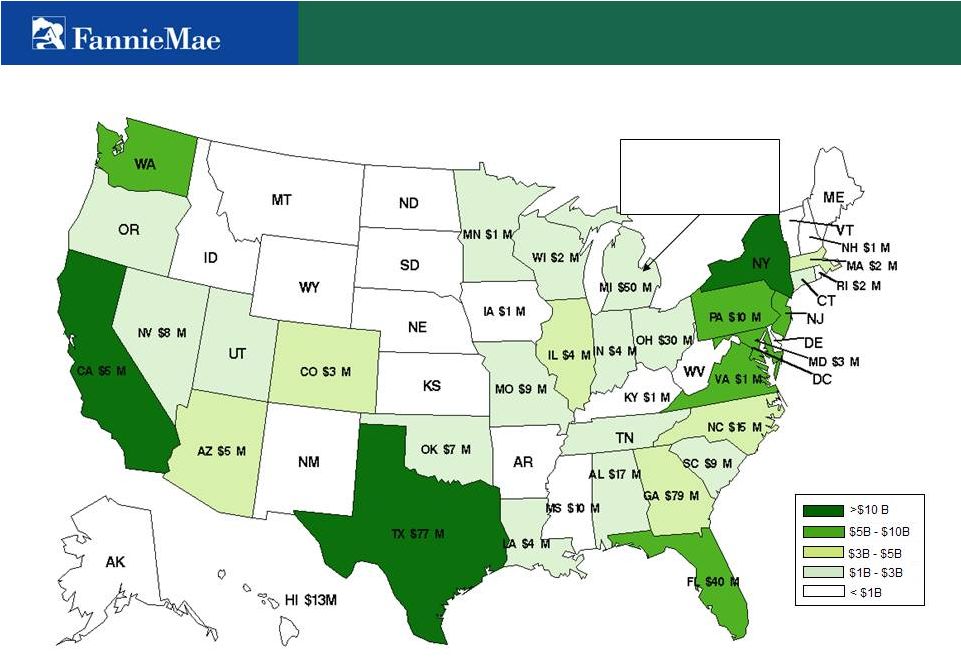 20
Fannie Mae Multifamily 2011 Credit Losses by State ($ Millions)
Example:
UPB in
Michigan is $2.6B and
2011 Credit Losses have
been $50M
Numbers:
Represent
2011
credit
losses
for
each
state
which
total
$410
million
(2)
as
of
December
31,
2011.
States
with
no
numbers
had
less
than
$1
million
in
credit
losses
in
2011.
Shading:
Represents
Unpaid
Principal
Balance
(UPB)
for
each
state
which
total
$192.7
billion
as
of
December
31,
2011.
Portfolio UPB
(1)
Concentration by State
as of 12/31/2011
(1)
Excludes loans that have been defeased. Defeasance is prepayment of a loan
through substitution of collateral. (2)
Excludes $19 million of credit-related income from other Multifamily Mortgage
Business investments. |
